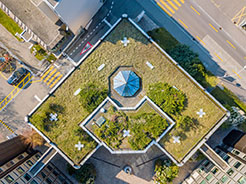Green Roof Systems – possible driver for growth in the roofing market?

According to data published in Livingroofs.com’s first UK Green Roof Market Survey (July 2017), the estimated total area of ‘green’ roofs in the UK has increased from 3.7 million m2 in 2014 to over 4.5 million m2 in 2016. Within the last 3-5 years, demand has continued to grow, consequently installation costs have fallen, and maintenance costs can be considered excessive, particularly for intensive green roofs. However, the added value that green roofs given to buildings, in particular where private outdoor space is a premium, offset these issues.
A ‘green roof’ is defined as any roof that is designed to include growing vegetation. This includes roof terraces, roof gardens and ‘lawn’ roofs, and ranges from containerised planting schemes placed upon conventional roofing systems to fully subterranean accommodation overlaid with conventional soil structures.
There continues to be a growing demand for green roofs in large city areas, particularly London, where there are serious concerns about rising pollution levels, declining air quality standards, increased flooding due to concreting over green spaces and a chronic shortage of private gardens. Over 40% of total green roof stock is in London, with a higher proportion of extensive roofs owing to the relative lack of space available for private gardens in Central London. Most green ‘roof installations are on high-end apartment complexes and large commercial buildings, which incorporate plants that absorb certain pollutants, divert rainwater run-off away from the streets and offer private outdoor space away from the general noise and hubbub.
Around 80% of the area installed are ‘extensive’, low maintenance, lightweight but typically unable to support foot traffic. ‘Intensive’ roofs are higher maintenance and more heavily used, mainly as roof gardens, parks and/or for urban agriculture. Although there is no legislation requiring the specification of ‘green roofs’, concerns about surface water run-off, enhancing biodiversity, pollution and poor air quality in built-up areas are generating interest and initiatives among business owners, architects and residents.
Recent Posts
- Key Trends and Market Dynamics in the UK Bricks, Blocks & Precast Concrete Sector
- Navigating Market Volatility: The Future of the UK Kitchen and Bathroom Distributors
- UK Kitchen and Bathroom Distribution: Growth, Challenges, and Opportunities
- Diesel Dominance and the Rise of Green Alternatives in the UK Generator Market
- From Diesel to Hybrid: Barbour ABI Maps UK Generator Hire Market Evolution


